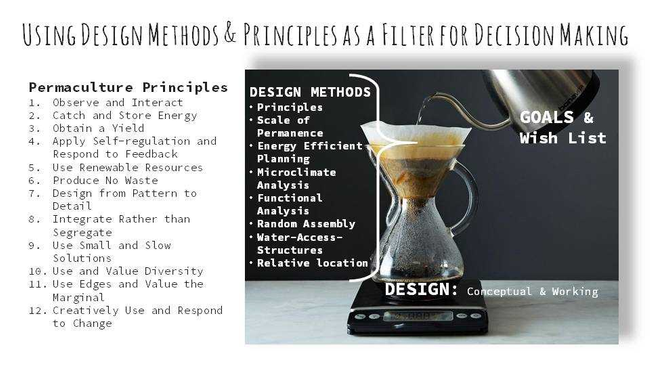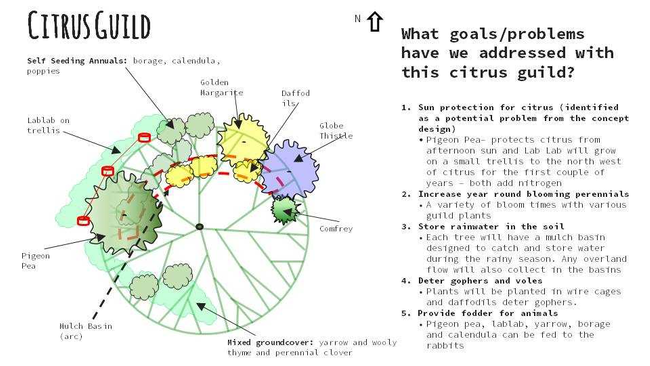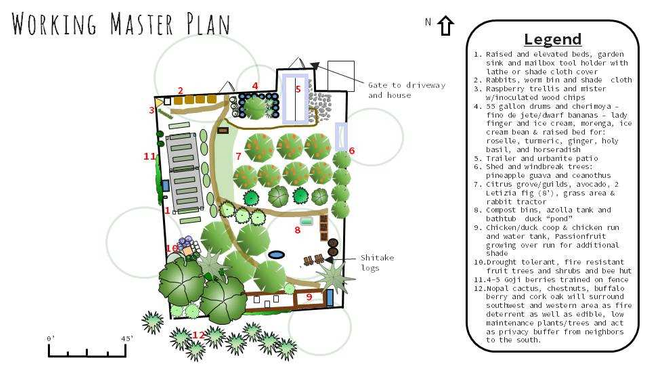By Laura Lukes, UC Master Gardener of Butte County, and Stephanie Ladwig-Cooper and Anne Ainsworth, Earthshed Solutions, January 5, 2018.
We begin where we left off in Part One: listening to the land. Earthshed Solutions board members Robert Henry and Anne Ainsworth spent three seasons in thorough observation of their private property, recording on a base map what the land told them. A recent presentation about their experiences (summarized here and in Part One) provided insight into how a virtually bare quarter-acre piece of their land (the Target Area) just southwest of their home site is being transformed into a permaculture garden.
Analysis of existing conditions, combined with the basic principles of permaculture, helped Henry and Ainsworth develop a list of goals and wishes, and shaped the design they developed for their working master plan. By carefully considering all of the conditions on their land, and by following the ethics and principles of permaculture, they had a system by which to filter their design choices.
Chief goals for the first permaculture ethic, “earth care”, were the following: restore damaged areas; increase habitat for wildlife, including plant and animal diversity; prevent soil erosion; and create compost and water storage areas. Primary goals for “people care” were: grow plants for personal use (food, herbs, flowers) and for year-round production from citrus and other fruit trees; create space for play and for hosting friends and family; and humanely raise animals (for food and pleasure). The third ethic, “fair share”, is being implemented by their willingness to share their property as a teaching and demonstration garden for Earthshed Solutions workshop participants. They have hosted several workshops through their 501(c)3 educational nonprofit organization. Courses they offer cover a range of subjects, including Energy Efficient Design, Solutions for Water Resilience, andContour Technology for Water and Land Restoration and Water Retention Strategies. Lastly, as a part of their master plan, they took an honest inventory of their abilities and limitations, such as age, strength, carpentry and equipment skills, and finances.
Their Wish List consisted of many things, including: building a citrus guild; privacy screening from neighbors to the south; protection from strong winter winds from the northeast; additional sheds for tool storage; ensuring easy evacuation for an existing trailer; and consolidating livestock in the areas which were best suited for the animals.
In the presentation, Brian Ladwig-Cooper discussed strategies and techniques which take the design process even further to the specific details of how one could implement the design on the ground. These strategies are the actions used to achieve design goals utilizing the permaculture principles as a guide. Techniques are the methods and tasks needed to implement the strategies.
According to Ladwig-Cooper, one always looks for techniques with multiple functions, capable of furthering more than one strategy and/or meeting several goals. For example, the Citrus Guild includes the use of many strategies and techniques to get the most out of the food-bearing guild. A guild is a group of plants based around a central element (for example, a fruit tree) which together work to build fertility, create a barrier from weeds, attract beneficial insects for pollination, provide mulch, and much more. Guilds are designed to mimic native plant communities.
The strategies which Henry and Ainsworth are utilizing on their land are water, access, soil, wind, and food. Here are descriptions of the ways in which they have addressed three of these five strategies and applied the use of specific techniques:
Water: Capture rainwater on site and store it in the soil. Each tree will have a mulch basin designed to catch and store water during the rainy season. Any overland flow will also collect in the basins.
Wind: Provide wind and sun protection. Both of these elements were identified as potential problems in the concept design phase. Pigeon pea shrubs and lablab beans will be planted as nurse (protection) species. The pigeon pea and lablab will protect the citrus from afternoon sun. A new shed and windbreak trees will be planted to the northeast of the guild to protect from winter winds.
Soil: Build up soil health and increase fertility. Both pigeon pea shrubs and lablab are nitrogen fixing which will provide this vital element to the plants and citrus as they grow. They can also be “chopped and dropped” as desired to increase overall soil health and add to the overall soil food web.
The working master plan illustrates the design that Henry and Ainsworth developed to meet their goals and wish list ideals, while remaining true to the bedrock ideologies of permaculture and Earthshed Solutions: to make a positive difference in how we live, farm, and work on our earth. Over the coming years, these two permaculture practitioners will continue to refine and improve their footprint on this land, as they listen closely to what the land tells them.
NOTE: Earthshed Solutions offers ongoing educational programs, one of which is the PermaBlitz, an organized community gathering where permaculture principles are applied through a full design on volunteer host property. Upcoming Pre-PermaBlitz Gatherings are scheduled for February 18, and March 18. The PermaBlitz itself will be held in April. Please check their website, www.earthshed.org for more information.


